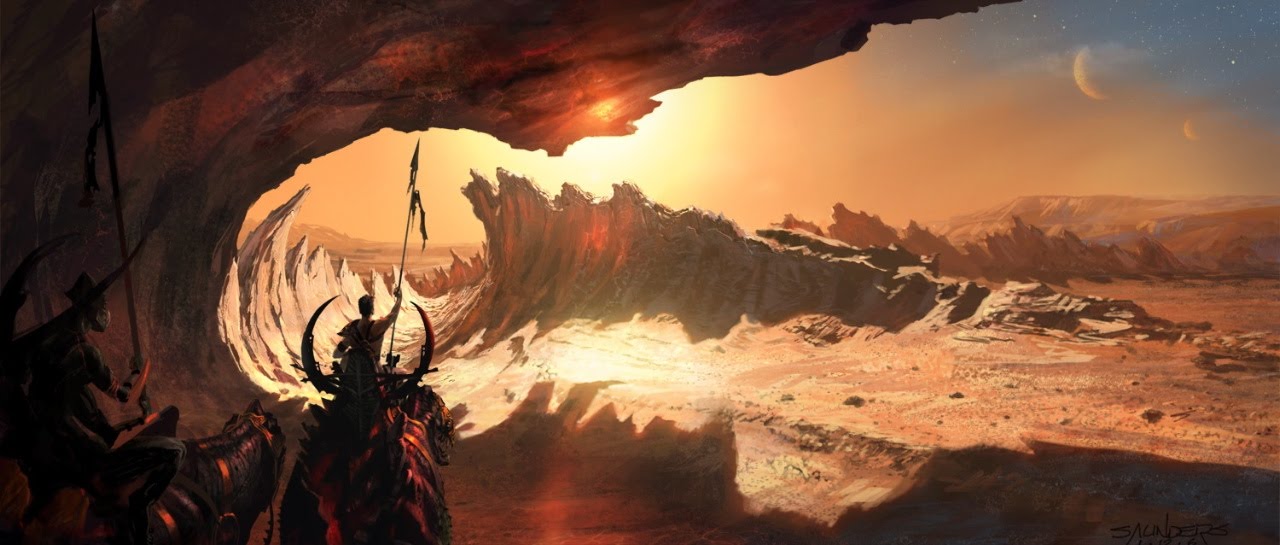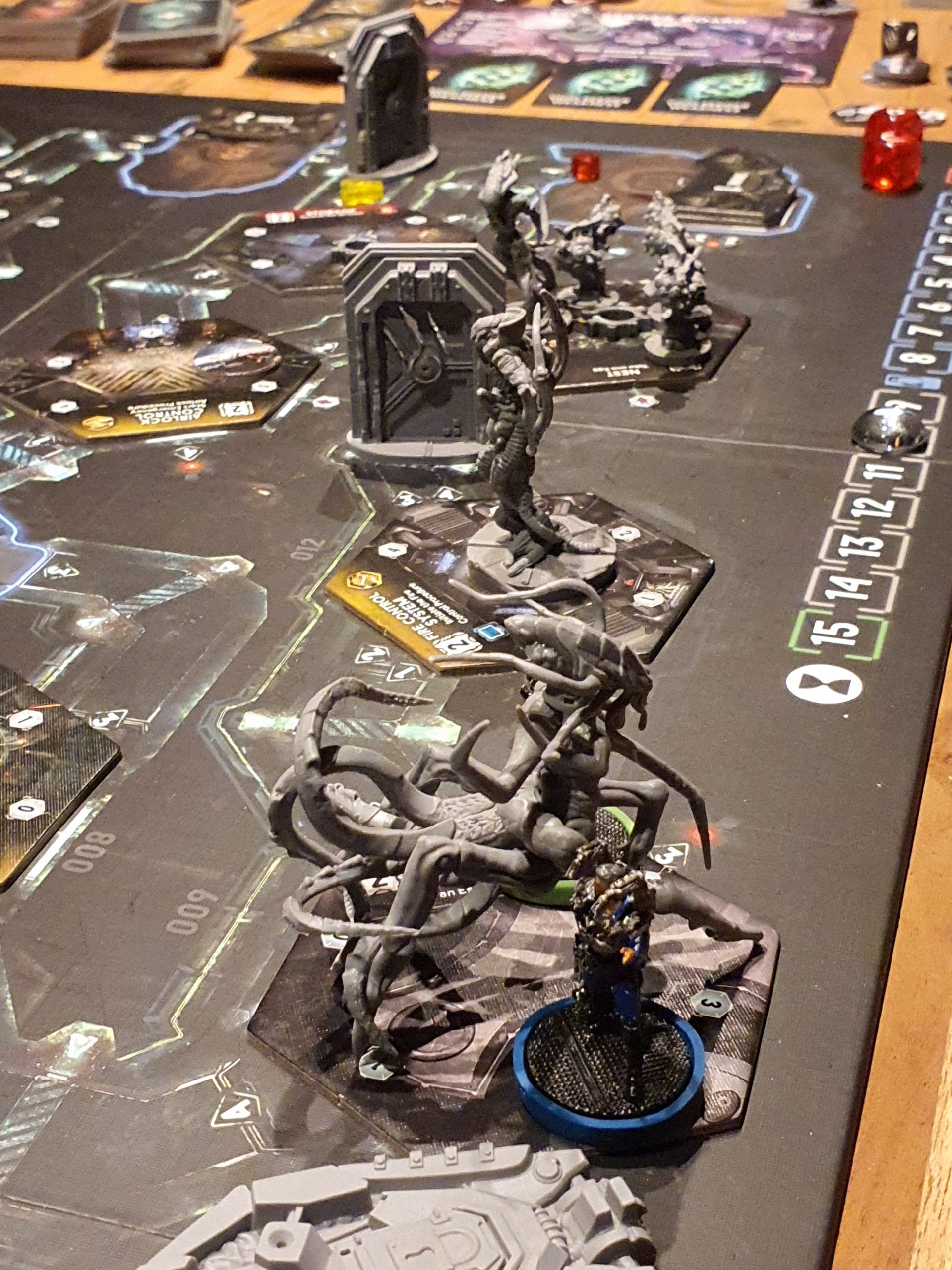As the second part of my three part post on magic in Athas, I’m going to focus on the psionic side of my Athasian ruleset.
My previous post on the topic, dating back well over a year ago, hinted at a series of new posts on Athas. I’m trying to get into a rhythm of posting more often, let’s see where we will get.
I’ve been working on my own players guide to Athas for quite some time. Besides the obvious things like the races being present (and, spoiler alert, those who have been exterminated) and how they are somewhat different then your regular PHB races, I’ve brought in some new things. They all concern spellcasting of some sort: the Cleric Elemental Domains, Psionics and Defiling/Preserving.
I plan to do a small post on all three and after spending time on defiling/preserving, I will be focusing on Psionics in this part. Let’s do a small bit of recap…
How do spells work on Athas?
First off, let’s start with some basic concepts and how I plan to apply them to my campaign setting. Magic has corrupted the lands of Athas. In a normal D&D campaign, a wizard would get the fuel for their spells from some mystical power, a wind of magic, etc. For playing purposes, it’s just there and usable at a somewhat infinite usage. On Athas, Arcane magic is fueled by life force, mainly plant life.
But what about Paladins, Clerics, and Druids! They use Divine Magic. Well, you are right, dear reader, but the gods are cut off from Athas. Either through some battle with the elementals or because of events cutting Athas off most planes of existence, the Gods of D&D have no influence on Athas. The Clerics, Paladins, Druids revere on of the elementals (good/neutral) or para-elementals (evil) As such, divine magic has been renamed Elemental Magic, but works more or less like the PHB rules.
Thirdly, there are Psionics on Athas. In fact, there is a lot of it. Psionics are fueled with inner strength, so by the manifester herself. As a quick overview, the classes are powered by these three sources (arcane, elemental and psionics)
| Class | Magic Source |
| Artificer | Arcane (Preserving or Defiling), or perhaps elemental? (discussion pending) |
| Barbarian | If a magic power is present, it would most likely be psionic or elemental |
| Bard | Arcane (defiling) or perhaps Psionics? (discussion pending) |
| Cleric | Elemental |
| Druid | Elemental |
| Fighter | If a magic power is present, it will most likely be psionic |
| Monk | If a magic power is present, it will most likely be psionic or elemental |
| Paladin | Elemental |
| Psionicist | Psionics |
| Ranger | Elemental |
| Rogue | If a magic power is present, it will most likely be psionic |
| Sorcerer | Arcane (Defiling) |
| Warlock | Arcane (Defiling / Sorcerer-King for Templars) |
| Wizard | Arcane (Preserving or Defiling) |
The Bard and Artificer are still subject to change because I’m still not sure in what way they would operate within Athas. Athassian Bards are assassins, poisoners, and in previous editions they where portrayed as a rogue subclass. Most 5e conversions I’ve seen so far, just eliminate the PHB bard class entirely and add a new Rogue subtype. I however, want to keep the PHB classes available as much as possible. Obviously, trying to boost morale on a crowd by singing a song while all life around you whither and dies, might not work as well. So trying to use the PHB Bard class should be something to be discussed with your DM. One idea I’m discussing is having the Bard class use psionics as casting source. I will try and discuss this on a new post on Psionics. This also makes it more clear that the 5e bard is not just a singer/musician as in older editions. Bards can be so much more through their traditions that it feels a shame to just junk it.
Artificer is a class that didn’t exist in the previous editions in Athas. It’s a strange class for Athas in multiple ways. In default, I feel it’s a class that highly depends on tinkering things, usually with metal. Athas is scarse on metal, so that might not work. This would really depend on the subclass and how the player and the DM see it work within the world. A suggestion I got was to use elemental power source, and that could definately make sense. However, there are still a lot of details to work out. I will try and discuss this on a new post on Elemental Magic.
Other half-casters with specific subclasses will need to be discussed on a per case basis. Some might be psionics, some might be elemental, and some will remain arcane and have to live to deal with the tough choice between preserving and defiling…
Magic Source: Psionics
Psionics is somewhat common in the world of Athas. No, this does not mean everybody has heavy psionic powers, it doesn’t even mean you will encounter a lot of psionic casters. But it’s a generally accepted way of casting and formal training does not need to be underground.
Psionics in Athas is also named The Will (being adapt to psionic powers) and The Way (having had training, and generally being able to do more then cantrips) is something you learn by practicing. There is no single method of teaching or learning it as it’s all internal. A master can only guide you to find your own way, and that will probably be a different way then she would do it herself.
Most of my Psionics ruleset for 5th edition is PHB based, with variant rules from the PHB/DMG. The rest is just other names for the same principles.
| Arcane term | Psionics term |
| Caster | Manifester |
| Cantrip | Talent |
| Spell | Power |
| Domain | Discpline |
Psionic Nexus
By luck, or as part of learning the Way, the Psionicist unlocks her Psionic Nexus. This is the focus used to manifest powers. This in-mind construct fuels the psionic powers to outside of her body. An Arcane caster would carefully speak an incantation, perform certain gestures and/or use material components. A Psionicist constructs the spell within her mind and manifest it onto the world.
Aside from specific changes in this article, Psionic casting follows the ‘Casting a spell’ rules found in Chapter 10 of the Player’s Handbook.
Psionic Power Displays
Psionic powers come from the body, or the Nexus as Psionicists call it. Manifesting a psionic power does not use spellcasting material components, there are no words spoken, or hand movements. Instead, any time when you manifest a psionic power, the base spell components are replaced with power displays.
Verbal (V) components are replaced with Visual (V) displays, Somatic (S) components with Sonic (S) displays, and finally Material (M) components with Mental (M) displays. These displays are not disruptive to a creatureΓÇÖs concentration.
Unless a cost is indicated for a material component, manifesting does not require any material components. If a cost is indicated for a material component, the manifester is required to have that component as a psionic focus, that may or may not be consumed in the process. (as per its base spell)
Visual (V): Your eyes burn like points of silver fire when you manifest and lasts as long as the ability or effect remains active. Expressions are also accompanied by displays that relate to the ability or effectΓÇÖs function. Hold person, for example, may appear as transparent chains springing from the ground and wrapping around your target, while telekinetic bolt might ripple the air between you and your target. These displays can be unique to the individual psion and are commonly seen as their personal signature.
Sonic (S): A bass hum, eerily akin to many deep-pitched voices, issues from your vicinity (or the area of effect). The sound grows within seconds from a whisper to being loud enough to be heard within 30 feet. Some abilities and effects may describe a unique auditory display; for example, manifesting thunderwave would be accompanied by the boom of thunder.
Mental (M): A subtle chime rings once in the minds of creatures within 15 feet of both you and your target (or the area of effect). You may choose to have the chime ring continuously for the duration of the ability or effect. Some abilities and effects may describe their unique mental displays.
Manifesting with Subtlety (Optional Rule)
While manifesting a power or talent is a mental exercise, it creates outward effects that can betray the psionicist. These effects can be suppressed.
If manifesting a psionic power or talent, you may attempt to suppress the manifestationΓÇÖs displays. Supressing the manifestation’s display requires your concentration. You can, however, concentrate on the newly manifested power. To suppress the display(‘s), you must make a manifesting ability check with a DC equal to 16 + power’s level. The DC for suppressing the display of a psionic talent is 16. Failure means that all onlookers, active or passive, automatically know that you manifested psionics, just like normal manifesting. If you succeed at manifesting with subtlety, the result of your check becomes the DC for onlookers to perceive the effect with either their passive or active Perception, depending on the situation. Bonuses and penalties to this check are at the GMΓÇÖs discretion. Regardless of the success at manifesting with subtlety, the psionic power is cast as normal.
Psionic Power Points
A manifest uses power points. This is simply a rename of the Spell Points variant, as described on pages 288-289 of the Dungeon Master Guide. All references to spells are renamed to powers.
To give a quick summary. Each power is powered by a certain amount of power points. The number of points required per power level and the maximum number of points are given in the tables below.
| Class Level | Power Points | Max Power Level |
| 1st | 4 | 1st |
| 2nd | 6 | 1st |
| 3rd | 14 | 2nd |
| 4th | 17 | 2nd |
| 5th | 27 | 3rd |
| 6th | 32 | 3rd |
| 7th | 38 | 4th |
| 8th | 44 | 4th |
| 9th | 57 | 5th |
| 10th | 64 | 5th |
| 11th | 73 | 6th |
| 12th | 73 | 6th |
| 13th | 83 | 7th |
| 14th | 83 | 7th |
| 15th | 94 | 8th |
| 16th | 94 | 8th |
| 17th | 107 | 9th |
| 18th | 114 | 9th |
| 19th | 123 | 9th |
| 20th | 133 | 9th |
| Power level | Point Cost |
| 1st | 2 |
| 2nd | 3 |
| 3rd | 5 |
| 4th | 6 |
| 5th | 7 |
| 6th | 9 |
| 7th | 10 |
| 8th | 11 |
| 9th | 13 |
Instead of gaining a number of spell slots to cast, like arcane casters, you gain a pool of power points instead. You expend a number of power points to create a manifestation slot of a given level, and then use that slot to manifest a power. You can’t reduce your power point total to less than 0, and you regain all spent power point when you finish a long rest.
Powers of 6th level and higher are particularly taxing to manifest. You can use power points to create one slot of each level of 6th or higher. You can’t create another slot of the same level until you finish a long rest.
Half-Manifesters
The power point table above is meant for full manifesters. For half-casters halve the character’s level in that class and then consult the table. For a fighter (for instance a psionic Eldritch Knight) or rogue (Arcane Trickster), divide the character’s level in that class by three. As described in this posts introduction, I’m not sure yet what source to use for each subclass. A DM should look into it themselves and decided wetter they should follow the half or third manifesters rule for their own games.
Wild Talent
Psionic energy suffuses Athas, making it the most common and accessible power source. Most inhabitants of Athas are born with some small aptitude for psionics. In time, these abilities can develop into psionic tricks called wild talents.
At the Dungeon MasterΓÇÖs discretion, a player can select one wild talent when he or she creates a character for a DARK SUN campaign.
Body Equilibrium
Wild Talent Cantrip
- Casting Time: Bonus action
- Range: self
- Components: Psionic (V)
- Duration: instantaneous
While moving, you gain advantage to Acrobatics checks to balance and do not sink when moving over soft or brittle terrain, such as dust, silt, mud, snow, or thin ice.
Far Hearing
Wild Talent Cantrip
- Casting Time: 1 action
- Range: self
- Components: Psionic (V)
- Duration: instantaneous
Choose one point on the ground you can see that is within 50 feet of you. Until the end of your next turn, you can hear as if you where at that place.
Know Direction
Wild Talent Cantrip
- Casting Time: 1 action
- Range: self
- Components: Psionic (V)
- Duration: instantaneous
You determine which way is north. For 1 hour, you gain advantages to checks to navigate natural terrain using either Perception or Survival.
Mental Tools
Wild Talent Cantrip
- Casting Time: 1 action
- Range: self
- Components: Psionic (V)
- Duration: instantaneous
You create a simple tool you can hold in one hand. The object appears in your hand or at your feet. You can not use the object to attack or hinder another creature. The object lasts until the end of the encounter or until you use this power again.
Object Projection
Wild Talent Cantrip
- Casting Time: 1 action
- Range: self
- Components: Psionic (V)
- Duration: instantaneous
You teleport an object you are holding in one hand to an unoccupied square within 50 feet of you, or to a willing creature within 50 feet of you.
Psionic Image
Wild Talent Cantrip
- Casting Time: 1 action
- Range: 10 ft centered on self
- Components: Psionic (V)
- Duration: instantaneous
Each target within 10 feet of you sees the image of a Small or smaller object in your hand or in a square in the burst. The image lasts until the end of your next turn.
Psionic Spark
Wild Talent Cantrip
- Casting Time: 1 action
- Range: 10 ft
- Components: Psionic (V)
- Duration: instantaneous
You focus on one flammable object within range that isn’t carried by another creature. It catches fire.
Sensing Eye
Wild Talent Cantrip
- Casting Time: 1 action
- Range: 25 ft
- Components: Psionic (V)
- Duration: instantaneous
Choose one point you can see that is within 25 feet of you. Until the end of your next turn, you can determine your line of sight from that square.
Telekinetic Grasp
Wild Talent Cantrip
- Casting Time: 1 action
- Range: 25 ft
- Components: Psionic (V)
- Duration: instantaneous
You target one object that weighs 20 pounds or less and isn’t carried by another creature. You can manipulate the target or move it up to 25 feet to a point within the spells range.
Thought Projection
Wild Talent Cantrip
- Casting Time: 1 action
- Range: 25 ft
- Components: Psionic (V)
- Duration: instantaneous
You can convey either an image or a message of 10 words or less to each target within 25 feet of you.
Random Wild Talent
Rather than letting players pick a wild talent, the Dungeon Master can have each player determine his or her characterΓÇÖs talent randomly, using a d10:
- Body equilibrium
- Far hearing
- Know direction
- Mental tools
- Object projection
- Psionic image
- Psionic spark
- Sensing eye
- Telekinetic grasp
- Thought projection
The Psionicist Class
I’m sure you are wondering by know, but where is the psionicist class itself? Well, I have my version on it under development. It’s a tricky class because I want to try and keep the old fashion style present of a weird kind of caster with serious commitment to their subclass. On the other hand, I don’t want to invent all kinds of new mechanics. (yes, I’m looking at you, Mystic class)
So my rough take on the class will be having a psionic die mechanic, like the psionic subclasses released so far, to fuel some abilities and having a deeper commitment to the disciplines. I’m planning to do that with different abilities and a strongly reduced generic power list. Each discipline will have something like a cleric domain list, but some more variation on the discipline list and less on the class list. This will also make sure that a seer (a psionic diviner) will have spells a kineticist (a psionic evoker) will never gain. This especially is taking more time to figure out to have all disciples be fun and hopefully balanced.
Acknowledgements
I did not invent all these rules myself. Credits, where credits are due: The Psionic display mechanic is part of the Codex of the Mind rulebook, that I funded on their kickstarter campaign. Although I don’t like every detail, it’s a good read to learn from and to adapt on. I’d advise you to take a look at it!



0 Comments